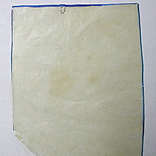
 Doesn’t look like much to me, but according to USDA’s Agricultural Research Service this is a picture of a prototype membrane that could be used to conduct ions in a hydrogen fuel cell. In an effort to reduce “American dependence on petroleum-based fuels,” researchers at ARS’ Environmental Management and Byproduct Utilization Laboratory in Beltsville, Md., have conducted preliminary studies which suggest the possibility of replacing the conventional petroleum-based main membrane in hydrogen fuel cells with biological products. Not saying exactly what the membrane is being made from except that it’s bio-based and non-petroleum made from “naturally occuring products.”
Doesn’t look like much to me, but according to USDA’s Agricultural Research Service this is a picture of a prototype membrane that could be used to conduct ions in a hydrogen fuel cell. In an effort to reduce “American dependence on petroleum-based fuels,” researchers at ARS’ Environmental Management and Byproduct Utilization Laboratory in Beltsville, Md., have conducted preliminary studies which suggest the possibility of replacing the conventional petroleum-based main membrane in hydrogen fuel cells with biological products. Not saying exactly what the membrane is being made from except that it’s bio-based and non-petroleum made from “naturally occuring products.”
Wisconsin Senate Kills Ethanol Bill
The Wisconsin Senate indefinitely postponed action on legislation that would have required that all gasoline sold in the state contain ten percent ethanol, effectively killing it this legislative year.
A press release from the Wisconsin Ethanol Coalition said that they will continue “efforts to promote the ethanol industry and its benefits to Wisconsin.”
Majority Leader Dale Schultz issued a statement expressing his disappointment over the outcome. “While the bill is dead for this session, I’m committed to working with supporters of ethanol, agriculture, the environment, and job creation to ensure we can bring the issue back next year.” Senator Shultz is a Republican from one of the state’s major corn growing areas.
The Capital Times says it was a rare example of bipartisanship in the State Capitol, with 12 Republicans and five Democrats voting to indefinitely postpone the bill, which had already been passed by the Assembly and would have been signed by the governor. The Times also noted Sen. Luther Olsen, R-Ripon, recused himself from voting because of business ties to the ethanol industry.
Meanwhile, that “ties to ethanol” issue surfaced this week for some lawmakers in Missouri where they are also considering a ten percent ethanol mandate, according to an AP article .
Kissing the Bricks
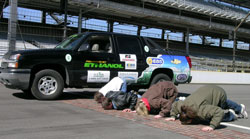
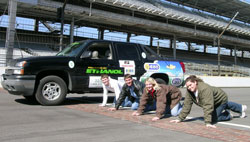
These pictures of the ICARE Cross Country E85 team – Alex, Bradley, Ashley and Tami – at the Indianapolis Speedway are so adorable I wanted to highlight them in a separate post so they wouldn’t be missed. Photo credits go to Whitney Copeland Cole of Indiana AgriNews who was the only media person at the Indy with the group. Great shots! Thanks again Whitney.
According to team member Bradley Westrum from the Day 2 post – we were only able to go a top speed of about 50 miles per hour. It truly was the opportunity of a life time. We stopped on the second lap to kiss the Brickyard, which is the strip of bricks that lay across the finish line, and is where every winner of a race that is held there, stops and kisses the bricks. After completing the second lap, we went through the pits, and concluded one of the most exciting parts of the trip. When we got back on the road we calculated how many laps we could complete on the track with one tank of E85. We figured that you could complete about 170 laps before running bone dry.
Captain’s Blog – Stardate 03.08.06 – Day 3

 The continuing saga of the Cross Country E85 trip….courtesy of Bradley Westrum, blogging his way across the USA in a flex-fuel Chevrolet….still working on getting some pictures to go with these posts.
The continuing saga of the Cross Country E85 trip….courtesy of Bradley Westrum, blogging his way across the USA in a flex-fuel Chevrolet….still working on getting some pictures to go with these posts.
March 08-06 – Today we got up around 5:15 to get ready for our big press day in Ankeny, Iowa. Arriving at the gas station around 6:30 we started to take interviews. KCCI Channel 8 News was there to do a live broadcast, as well as the Fort Dodge Messenger, and the Farm Bureau Spokesman. We talked to Van and Bonnie of WHO radio, Doug Cooper on WOI radio news show, and KJAN radio in Atlantic, via cell phone. Sponsors that were in attendance to the fill up in Ankeny were the American Lung Association, National Ethanol Vehicle Coalition, Iowa Renewable Fuels Association, Representatives from General Motors, and Karl Chevrolet. Senator Beall from Fort Dodge, Iowa paid for the fuel and filled the Avalanche’s tank. After spending a few hours at the Kum&Go doing lots of interviews, we got back on the road. We filled in Council Bluffs, IA then headed for Nebraska where we filled up in North Platte. In North Platte, we found out that the roads were questionable due to a major storm sweeping across the Midwest. After filling the tank, we booked it to Sidney, NE where we would decide whether to keep going on or not.
When we got to Sidney we stopped at a truck stop, where we heard that I-80 was closed at Cheyenne, Wyoming. Cheyenne was where we planned to drive to and spend the night in anyway, so we decided to brave the storm and head west. The roads were just wet, and it rained and snowed on us the most of the way, but the roads stayed decent. We stopped at a rest stop between Sidney and Cheyenne and it turned into a huge snowball fight, being that it has been a while since we have seen snow in Iowa. Thankfully we pulled into Cheyenne a little after 7:30 Mountain time, and filled up the tank, paying the lowest price of the trip, $1.74, an amazing $0.37 lower than regular fuel. Trying to find a hotel during a storm turned out to be a daunting task, but we were successful on our third try, and thankful that we were not forced to sleep in the Avalanche.
Tomorrow our task is to get across the Rocky Mountains, where a storm is expected, but more on that on tomorrow’s blog.
The Wild Green Yonder?

 Bio jet fuel could be the next frontier for domestic fuel. I had to do some hunting to find the original article on the research being done at the University of North Dakota to make jet fuel from crop oils, but I finally found it in the Grand Forks Herald. According to the story, the military is very interested “because it helps decrease dependence on foreign oil.” One of the next stops for the biojet fuel this spring is Wright-Patterson Air Force Base in Ohio to have it inspected at the base’s fuels-testing lab. The last time UND researchers were at Wright-Patterson, Air Force scientists said they were interested in the new biojet fuel because it performed as well as regular JP-8 jet fuel. But they were concerned with its ability to operate in extreme cold temperatures, and it tended to “gum up” after long periods in storage.
Bio jet fuel could be the next frontier for domestic fuel. I had to do some hunting to find the original article on the research being done at the University of North Dakota to make jet fuel from crop oils, but I finally found it in the Grand Forks Herald. According to the story, the military is very interested “because it helps decrease dependence on foreign oil.” One of the next stops for the biojet fuel this spring is Wright-Patterson Air Force Base in Ohio to have it inspected at the base’s fuels-testing lab. The last time UND researchers were at Wright-Patterson, Air Force scientists said they were interested in the new biojet fuel because it performed as well as regular JP-8 jet fuel. But they were concerned with its ability to operate in extreme cold temperatures, and it tended to “gum up” after long periods in storage.
Sunshine State Ethanol Talk
Couple of ethanol news items from Florida.
 First, Commissioner of Agriculture Charles Bronson mixed ethanol with strawberries at the annual Strawberry Salute Breakfast Monday, calling on the state’s agricultural community to become a leader in ethanol production. According to this story in the Lakeland Ledger, Bronson talked up a new biofuels process developed by the University of Florida’s Institute of Food and Agricultural Sciences (IFAS) that can make ethanol, a synthetic fuel, from agricultural waste products. I had been saving the press release about that process, which was actually sent out in May of last year, meaning to do a story about it someday. And I will. But, meantime, here’s the link so you can read it yourself.
First, Commissioner of Agriculture Charles Bronson mixed ethanol with strawberries at the annual Strawberry Salute Breakfast Monday, calling on the state’s agricultural community to become a leader in ethanol production. According to this story in the Lakeland Ledger, Bronson talked up a new biofuels process developed by the University of Florida’s Institute of Food and Agricultural Sciences (IFAS) that can make ethanol, a synthetic fuel, from agricultural waste products. I had been saving the press release about that process, which was actually sent out in May of last year, meaning to do a story about it someday. And I will. But, meantime, here’s the link so you can read it yourself.
Next, there is a reason why the Cross Country kids are heading through the middle of the US rather than going south – there’s no E85 stations in Florida. The Miami Herald did a feature on ethanol Sunday which noted that E85 is not even approved for sale in Florida yet, but is expected to be soon. This is interesting because the state’s Department of Agriculture and Consumer Services – which is run by Commissioner Bronson – is the agency that regulates gasoline sales in the state. According to the article, Matthew Curran, chief of petroleum inspection for the Florida Department of Agriculture, which oversees fuel standards, said that as early as next month new rules that would allow the sale of E85 in the state could be in place. ”The department is trying to take a proactive stance,” he said.
Captain’s Blog – Stardate 03.07.06 – Day 2
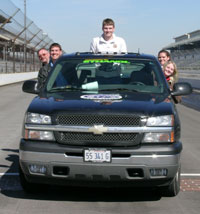 The E85 Cross Country Tour went through the midwest on Tuesday and got to do some fun things in Indianapolis before landing in Des Moines on Tuesday night. Here is the second installment of their adventures. We will be posting pictures from the trip as soon as we get them. (By the way – I have no idea what “Piddidle!” means – I hope it’s not a bad thing!)
The E85 Cross Country Tour went through the midwest on Tuesday and got to do some fun things in Indianapolis before landing in Des Moines on Tuesday night. Here is the second installment of their adventures. We will be posting pictures from the trip as soon as we get them. (By the way – I have no idea what “Piddidle!” means – I hope it’s not a bad thing!)
Just added one of the pictures of the group on the track at the Indy – with mega thanks to Whitney Copeland Cole of Indiana AgriNews for sharing a few of her photos. More in a separate post. THANKS WHITNEY!!!
Tuesday, March 7, 2006:Leaving at a nice bright and early time of 7:00 to meet the Ohio Clean Cities Representative Erika Wiggins, a local Columbus radio station, and a NBC TV station affiliate out of Columbus, Ohio, where we filled up the tank. After leaving Hilliard we started the longest day of the trip. Our second stop came about 4 hours into the day in Indianapolis, Indiana, were we filled up at Joe’s Junction, where a very nice man named Gilbert set us up with a very scrumptious meal of fried chicken, pork fritters, potato wedges, and all the fixin’s. Joe’s Junction also footed the bill for the fuel. We were interviewed by a woman named Whitney Cole who is a field editor for AgriNews Publications. After leaving Joe’s Junction, Ms. Cole followed us to the Indianapolis 500 Speedway. We made a call earlier and set up an opportunity of a lifetime. Upon arrival to the Speedway, we entered under the tunnel which went under the speedway. When reaching the other side we were inside the inter oval of the track. The flip of the coin determined the driver, since we could not rotate drivers on the track. We had to follow a lead car carrying Danny Edwards who is in Public Relations for the track, and Ms. Cole rode in there as well. Unfortunately we were only able to go a top speed of about 50 miles per hour. It truly was the opportunity of a life time. We stopped on the second lap to kiss the Brickyard, which is the strip of bricks that lay across the finish line, and is where every winner of a race that is held there, stops and kisses the bricks. After completing the second lap, we went through the pits, and concluded one of the most exciting parts of the trip. When we got back on the road we calculated how many laps we could complete on the track with one tank of E85. We figured that you could complete about 170 laps before running bone dry. We had to put the pedal to the metal to get to the next stop because of how long the day is. The next stop was in Kankakee, IL, were we filled up the tank. This gas station is owned by VeraSun Energy, who is one of our sponsors, and is also the owner of the Ethanol plant in Fort Dodge, IA. Back on the road again, the third stop of the day was in Normal, IL. When we arrived at Normal, IL we were met by 2 local radio stations, the Illinois AgriNews, Illinois Corn Growers, Illinois Farm Bureau and representatives from General Motors. The Illinois Corn Growers purchased our tank of E85. The Illinois Clean Cities purchased snacks and refreshments at the gas station for our long journey ahead. Later that day, we stopped at Hardees and engulfed delicious Angus burgers before we arrived in Des Moines, IA. We arrived at the Heartland Inn at 9:30 p.m. and soon were in a deep slumber. “Piddidle!!!”
“See the USA in your Flex Fuel Chevrolet…”
Captain’s Blog – Stardate 03.06.06 – Day 1
Here is the first of the blog updates from the Cross Country E85 trip. The update was written by Bradley Westrum and emailed to us by Alex Lundgren, who decided to go home when they arrived in Des Moines Tuesday. The rest of the crew, which includes students Ashley Heflin and Tami Davis and teacher/chaperone Jim Richardson, are continuing on their journey to Los Angeles.
March-06-06 Starting our day off waking up around 7, we met in Jim’s room at 8, where we left to go to eat breakfast at a diner on the corner a block away from our hotel. Getting our food faster than expected, we had time to attempt to go fill the Avalanche with E85 before Senator Grassley arrived at the hotel. Unfortunately our attempt to find E85 failed, when we could not find the gas station that sells the fuel. With the driving time consumed trying to find E85- our time was running short, so we decided to head back to the hotel to meet Sen. Grassley. Sen. Grassley arrived with his staff a few minutes after we got back to the hotel parking lot. When Sen. Grassley pulled into the parking lot, he got out and jumped in the Avalanche and Jim got in the car with his staff. Sen. Grassley rode with the students, and directed them the easiest way to the Capital. Upon arrival we went through security, and pulled right up to the steps of the Capital building, then were interviewed by WHO radio, and our picture was taken numerous times in front of the car with the Capitol in the back ground. After complaining enough about not being able to find the station that E85 is available, Bob Dinneen who is the President of the Renewable Fuels Association rode with use to the station, filled up the Avalanche, and paid for it. Mr. Dinneen pointed out that the Pentagon which was just behind the station that we filled up at, faced the area where on 9-11 the terrorist drove the plane into the outer wall. After navigating our way under the instruction of Mr. Dinneen back to the Capitol, we dropped him off, and headed on our way. Just so all you know, navigating Washington D.C. is a daunting task, especially with 5, farm raised Iowans at the helm. Although we found out that Mr. Dinneen who has lived in D.C for more than 30 years can slip up and make a wrong turn. After collecting our things and checking out of our hotel, we started on our way with a full tank of E-85. When leaving D.C we were flagged down by a woman driving a 2001 Pontiac Montana. She waved at us, we rolled down our window, and she asked, “Where can I get that,” of course referring to the huge Ethanol signs and decals on the side of our Avalanche. So we explained to her that she will need to update, and get herself a new Chevrolet. The second fill stop on the trip was in Morgantown, West Virginia. We decided to bypass the town, hopefully cutting out an opportunity to get lost. We went the long way around the town and then back tracked. The map that we followed, lead us down a small, dilapidated dirt road, in hick town. Seeing that there probably wasn’t a gas station that offered E-85 we flagged down what we will call a close relative to Jed Clampet… (Beverly Hillbillies)… We asked him if there was a gas station that has 85% Ethanol, and he proceeded to answer use with, “WHO?” So seeing that this wasn’t going to make much progress we thanked him and turned back towards Morgantown. After finding the right road, we were lucky that there was a person working at this stop. We stopped at Delaney Oil Company, were we dealt with a pioneer in renewable recourses, and a real gem of a guy named Michael L. Kelly. After this stop, we were able to calculate and crunch the first numbers of the trip. We found that this vehicle will bring use no problems when we stretch the stops out when we continue to the west coast. More coverage tomorrow when we continue on the second day of the trip, when we continue through Ohio, Indiana, Illinois, and Iowa. “Piddidle!!!”
“See the USA in your Flex Fuel Chevrolet…
Petroleum From Poop – Definitely Crude
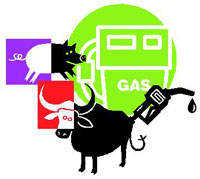 Illinois is using pigs, the Japanese are using cows – both are trying to get fuel from manure. The University of Illinois is designing “a pilot plant for a large commercial livestock farm that will convert swine manure to crude oil,” according to this press release from the university’s College of Agricultural, Consumer and Environmental Sciences or ACES.
Illinois is using pigs, the Japanese are using cows – both are trying to get fuel from manure. The University of Illinois is designing “a pilot plant for a large commercial livestock farm that will convert swine manure to crude oil,” according to this press release from the university’s College of Agricultural, Consumer and Environmental Sciences or ACES.
The pilot plant is based on research led by Yuanhui Zhang, an agricultural and biological engineer at the U of I. Zhang and colleagues developed a system using thermochemical conversion (TCC) to transform organic compounds (like swine manure) in a heated and pressurized enclosure to produce oil and gas. “The process we developed is different from most conventional TCC processes,” said Zhang. “There is no need for the addition of a catalyst, and our process does not require pre-drying of the manure.” Involved in the project are the Illinois Pork Producers Association, Worldwide BioEnergy (which is supposedly based here in Jefferson City, MO but I can’t find a website for them), Innoventor Engineering Inc., and BioCrude LLC (can’t find them either).
In Tokyo, according to this AP story, scientists are using cow manure to create gasoline. Sakae Shibusawa, an agriculture engineering professor at the Tokyo University of Agriculture and Technology, said his team has successfully extracted .042 ounces of gasoline from every 3.5 ounces of cow dung by applying high pressure and heat. “The new technology will be a boon for livestock breeders” to reduce the burden of disposing of large amounts of waste, Shibusawa said. Meanwhile, according to the article, “another group of researchers has successfully extracted an aromatic ingredient of vanilla from cattle dung.” I found this story from a link on humor columnist Dave Barry’s blog – and as he would say, I am not making this up.
I’m sure he would appreciate the graphic montage I put together to accompany this post.
EPIC & the IRL Get Tropical In Miami
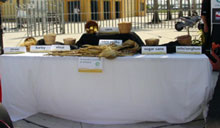 On Saturday I was travelling back from last week’s Commodity Classic so I didn’t get to attend the press conference held in Miami for the Indy Racing League and our sponsor, EPIC. However, we bloggers have our ways of getting information. You can find out what the things on the table in this picture are by reading below. So here’s what happened:
On Saturday I was travelling back from last week’s Commodity Classic so I didn’t get to attend the press conference held in Miami for the Indy Racing League and our sponsor, EPIC. However, we bloggers have our ways of getting information. You can find out what the things on the table in this picture are by reading below. So here’s what happened:
On Saturday March 4, the Indy Racing League and EPIC (Ethanol Promotion and Information Council) held a joint news conference at the Homestead Miami Speedway in Homestead Florida. The focus was the IndyCar Series fuel partnership, which kicks off this year. In 2006, the IndyCar Series racing vehicles will use a blend of 10% ethanol and 90% methanol (as opposed to 100% methanol that was used last year). In 2007, the IndyCar Series switches to 100% ethanol.
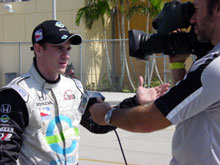 Team Ethanol driver Paul Dana (pictured) participated in the news conference and told his story about how he was instrumental in bringing the ethanol opportunity to the Indy Racing League. IRL executives Jeff Horton and John Lewis shared the reasons behind the switch. From the League’s perspective, it was a natural way to continue its leadership in racing to include burning an environmentally responsible fuel that performs beautifully in racing machines.
Team Ethanol driver Paul Dana (pictured) participated in the news conference and told his story about how he was instrumental in bringing the ethanol opportunity to the Indy Racing League. IRL executives Jeff Horton and John Lewis shared the reasons behind the switch. From the League’s perspective, it was a natural way to continue its leadership in racing to include burning an environmentally responsible fuel that performs beautifully in racing machines.
During the news conference, the biggest hit of the day was the “commodities”
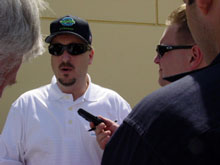 table (pictured above) where EPIC displayed various raw ingredients that are used to make ethanol. Reporters came over to run their fingers through the barley and wheat and find out just exactly what milo looks like!
table (pictured above) where EPIC displayed various raw ingredients that are used to make ethanol. Reporters came over to run their fingers through the barley and wheat and find out just exactly what milo looks like!
EPIC representatives Steve Rust and Tom Slunecka (pictured) talked to reporters from the racing media as well as local Miami radio and TV stations and newspapers.

